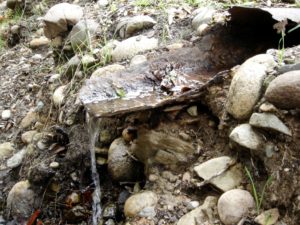
* Over 600 acres of Rocketdyne drain into Brandeis-Bardin and adjacent Runkle Canyon
* 1993, 1995 Rocketdyne reports show 19 elevated Strontium-90 soil sample readings
* Plutonium-239/240, Uranium-238 found in 2004 soil higher than later SSFL readings
* Elevated Strontium-90, beta radiation in 2005 water flowing into Brandeis-Bardin
* 2012 EPA soil and Boeing groundwater Area IV reports consistent with earlier results
* Nov. 2015 DOE finds rads identified as “fission products” and “used in reactor control rods”
* Nov. 2016 NASA report shows Brandeis-Bardin groundwater/wells chemical contamination
* Dec. 2016 DOE report given by camp owner American Jewish University (AJU) to Jewish Journal shows elevated Brandeis-Bardin soil toxins
* Brandeis-Bardin reports released by AJU show perchlorate in fruits and vegetables
* AJU denies all contamination in 2015, 2016, March 2017
* Dec. 2016 DTSC letter claims no SSFL rads migrated north, DTSC maps show otherwise
* Jan. 2017 DOE issues Draft Environmental Impact Statement (DEIS) proposing little cleanup
* Ventura County Board of Supervisors, Los Angeles County Board of Supervisors, Los Angeles City Council pass resolutions critical of DOE’s DEIS
A 13-year-long investigation of the Brandeis-Bardin Institute has revealed extensive radiation and chemical impacts across the 2,878 acre property in eastern Simi Valley, California. Multiple government and media tests and reports from 1993 through 2016 indicate that the site may have been contaminated by the bordering Santa Susana Field Laboratory (SSFL), commonly known as Rocketdyne.
Read more at BRANDEIS-BARDIN’S TOXIC DENIAL INVESTIGATION
Photos, videos, reports, figures, tests, data and special analysis
The Brandeis Camp Institute began in 1947 on 2,200 acres in eastern Simi Valley and by 1953 Camp Alonim (“oak trees” in Hebrew) was established. The camp soon became a new paradigm in Jewish adult and youth retreats for “a non-denominational, Jewish experience brought to life through sports, the arts, nature, and learning in a safe and embracing community,” according to its website. In 2007, the 250-student Bel-Air based University of Judaism merged with the institute resulting in the American Jewish University (AJU) and its Brandeis-Bardin Campus.
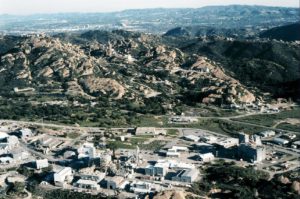
Recent media coverage of Brandeis-Bardin’s radiation and chemical issues, greeted with a howl of indignation by camp owner American Jewish University (AJU), has set the stage for this exposé which fully documents contamination findings and impediments to full cleanup.
“Sludge from Rocketdyne”
Lab tested soil and water samples from Brandeis-Bardin show that elevated levels of radiation. Plutonium-239 (Pu-239/240) and Uranium-238 (U-238) were found in the Jewish camp at levels even higher than they are at SSFL’s Area IV, according to soil tests from 2004 and water readings from 2005 that have been authenticated and verified by EnviroReporter.com.
Area IV is the 280 acre nuclear research part of SSFL, much of it draining into Brandeis-Bardin. Operated for decades by the Atomic Energy Commission and then the Department of Energy (DOE), and owned by Boeing, it is the site of three partial nuclear meltdowns including the Sodium Reactor Experiment in 1959. Area IV is grossly polluted by radiation and chemicals.
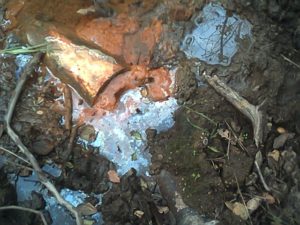
Tests were conducted for soil on December 30, 2004 and for water on November 23, 2005 from mud and a bubbling, chemical sheen-topped liquid at the bottom of a ravine in the upper reaches of Meier Canyon at the camp. Samples were subsequently sent for radiochemical analysis to STL Richland, a prominent Richland, Washington-based laboratory.
The 2004 STL Richland soil test results had to wait eight years before they could be compared to a reliable standard. The dirt’s radionuclides were then compared to “Background Threshold Values” (BTVs) developed for Area IV by the U.S. Environmental Protection Agency (EPA) in 2012. The government’s tests cost taxpayers $41.5 million and found high radiation as reported in Radiation Readings Soar at Rocketdyne.
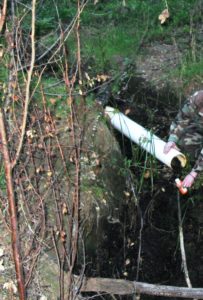
Area IV’s Former Sodium Disposal Facility (FSDF) drains down Channel D into Meier Canyon where the toxins were detected. The FSDF was used to dispose of barrels of radioactive sodium. Sodium reacts violently with air or water so workers would take lots on who would get to shoot the barrels with a rifle to make them explode outdoors. Debris was blown in all directions including down into Brandeis-Bardin according to an eyewitness account from a former Rocketdyne security guard recently recalled to EnviroReporter.com.
Gurgling goo was still flowing unimpeded in the exact same Meier Canyon location in 2014 when Simi Valley resident Brandon Manwell contacted EnviroReporter.com. Manwell had found the place hiking with friends. He videotaped and photographed it in April 2014 and the result is a YouTube video entitled Sludge from Rocketdyne. The skateboarder first thought he was in the upper reaches of Runkle Canyon, one mountain ridge away to the west, where KB Home’s controversial development called Arroyo Vista at the Woodlands is being built.
“Me and my friend found a few places just like this back in that canyon,” Manwell wrote in an April 19, 2014 email to EnviroReporter.com. “We wouldn’t have thought too much of it except for the fact that the water running out of this old pipe was iridescent, kind of like when water has oil in it, but it had a weird consistency when we touched it with a stick in the video. We weren’t sure what to make of it to be honest, we thought we should go back and get samples.”
Read more at BRANDEIS-BARDIN’S TOXIC DENIAL INVESTIGATION
Photos, videos, reports, figures, tests, data and special analysis
The 2004 and 2005 STL Richland radiological testing isn’t the only data available showing Brandeis-Bardin pollution detections. A DOE map showing chemical contamination reaching far into Brandeis-Bardin that is marked for possible remediation was shown at a public meeting April 22, 2014. That map listed offending chemicals on Brandeis-Bardin property which included dioxins, poly aromatic hydrocarbons (PAHs), phthalates and pesticides.
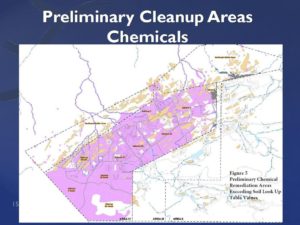
At the same meeting, DTSC officials straight-faced told the audience that SSFL pollutants were staying onsite, above and below ground. But the department later made public more information that confirms what the DOE and DTSC maps had already shown, this time with diagrams carefully plotting toxic trouble spots in the upper reaches of Brandeis-Bardin.
DTSC sent to EnviroReporter.com December 3, 2015 a Boeing report including maps of Brandeis-Bardin contamination [pp. 55-57/138 PDF pages; 10.89 MB] down what is called “Channel D.” This 2008 report explains that Boeing owns Area IV and the Northern Buffer Zone (NBZ), land transferred to Boeing in 1997 as part of the confidential settlement with Brandeis-Bardin over the camp’s land allegedly being contaminated.
The maps show at least eight chemically-impacted places in Channel D on Brandeis-Bardin property that would be cleaned up applying the standard that the DOE and NASA have committed to with DTSC in 2010, normal background. Boeing’s report suggests that’s unreasonable and recommends a drastically smaller cleanup, which is shown on its own map as removing from remediation the eight chemical hot spots in Channel D on Brandeis-Bardin’s property.
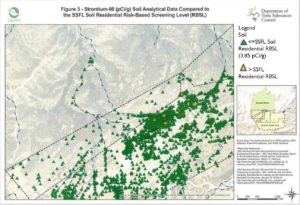
Problem was that the standard of 3.85 picocuries per gram (pCi/g) for Sr-90 that it used, apparently provided to DTSC by Boeing, was thousands of times less protective than the current EPA Residential Preliminary Remediation Goal of 0.00121 pCi/g. DTSC falsely declared almost of all the Strontium-90 in Area IV to be to be less than a residential risk-based standard, when in fact they are almost all above it. DTSC also should not have applied any risk-based standards to Area IV, since it is under the Administrative Order on Consent (AOC) to be cleaned up to background. (DTSC signed identical AOCs with the DOE and NASA in 2010 agreeing to remediate their areas of SSFL to background levels of radiation and chemicals under state authority.)
The maps strikingly, visually, and directly contradict recent statements by both AJU and DTSC. AJU has linked to just one page of that April 2016 presentation on its website, neglecting to include the maps that were in the very subsequent pages. Not to be outdone, in a December 22, 2016 letter to California Assemblymember Matt Dabaneh, DTSC claimed that, “there was no migration of radiological contamination north of SSFL.” This “nothing to see here, keep moving along” approach flies in the face of hard data, reports produced by DTSC itself, and established EPA regulations.
A November 2016 NASA groundwater report obtained by EnviroReporter.com also shows chemical contamination in a Brandeis-Bardin artesian well discharging water down a canyon, with toxic levels detected that exceed California Maximum Contamination Levels (MCLs) for drinking water. All water courses draining through Brandeis-Bardin, perennial and non-perennial, are considered ‘blue line streams’ protected by the Clean Water Act. The MCL overages in Brandeis-Bardin should, normally, be reported to the Los Angeles Regional Water Quality Control Board (LARWQCB). EnviroReporter.com has found no evidence that any such notification about Brandeis-Bardin’s MCL exceedance were ever reported to the board.
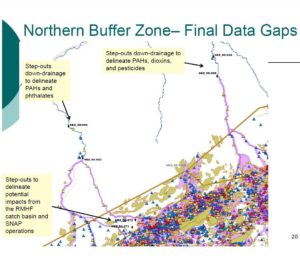
EnviroReporter.com has also uncovered additional evidence of SSFL toxins impacting the Jewish camp including 1993 and 1995 Rocketdyne reports showing Sr-90 over background in 19 separate soil samples. Cesium-137 was found in a NASA drainage into the camp and radioactive cow flops in Area IV were so hot that they threatened to re-contaminate the FSDF after one of its remediations. Camp videos feature revelers playing traditional Jewish instruments dancing near the potentially hot heifers.
None of this should be unexpected. Brandeis-Bardin borders and is in the drainage of the former Sodium Reactor Experiment (SRE) which partially melted down and released hundreds of times more radiation outdoors than did Three Mile Island in 1979 from the unfortified building. The SRE site and its surroundings still have massively contaminated areas with radiation at thousands of times background.
Radiation in the Dirt
When first found in 2004 at the bottom of a ravine under Area IV, the suspect substance looked as if it had been coming out of the pipe and ground for years. Based on eyewitness observations, photographs, videotape, and Rocketdyne and Boeing reports, EnviroReporter.com estimates that the liquid leaking into Meier Canyon Creek and flowing through Brandeis-Bardin has likely been in existence for decades.
The sampling site sits about 1,200 feet downhill of the Radioactive Materials Handling Facility (RMHF), the former SNAP experimental space nuclear reactors and the FSDF. Small space reactors partially melted down in Area IV in 1964 and 1969 releasing radiation into the environment.
The entire 2,850-acre mountaintop lab drains 612 of its chemically and radioactively impacted acres into Brandeis-Bardin. The AJU property is the largest Jewish-owned institutionally owned property outside of Israel. Ironically, it borders the lab which was started to test V-2 rockets under the guidance of the former Waffen SS-Sturmbannführer (Major) and rocketeer, Wernher von Braun.
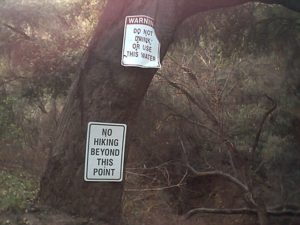
Pu-239/240 was found considerably higher in the Brandeis-Bardin dirt tested than the highest sample analyzed in the EPA’s 2011 radiation soil testing report in Area IV. A potent radionuclide with a half-life of 24,110 years, Pu-239/240 was collected and tested in a 2004 Brandeis-Bardin soils report [17 PDF pages; 805 KB] completed in 2005 by STL Richland. Both soil samples had higher Pu-239/240 than found in Area IV soils.
The peak 2004 Pu-239/240 sample exceeded its BTV by 55.2 percent. This extremely toxic, cancer-causing radioisotope produced during a nuclear reaction was precisely 21.6 percent higher than the “Maximum Value Detected” (MDV) for the radionuclide found in Area IV in the EPA’s October 2011 Final Radiological Background Study Report – SSFL [PDF page 282/286; 16.5 MB].
Read more at BRANDEIS-BARDIN’S TOXIC DENIAL INVESTIGATION
Photos, videos, reports, figures, tests, data and special analysis
Plutonium-239 is a nuclear reactor byproduct that has been called one of the most toxic substances on the planet due to its lethality and use in nuclear weapons. With a half-life of 24,000 years, it also hangs around for a very long time.
Rocketdyne and its successors have repeatedly denied the presence of Pu-239/240 on Brandeis-Bardin property, first in the 1995 report Additional Soil and Water Sampling – The Brandeis-Bardin Institute and Santa Monica Conservancy [535 PDF pages; 11.9 MB]. “Isotopic plutonium was not detected in any of the field samples collected during the study.”
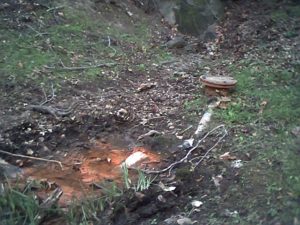
“The field lab sits at a higher elevation than the Brandeis-Bardin, any third-grader can tell you how the Plutonium 239/240 and Uranium 238 migrates offsite onto the camp,” said William Preston Bowling, founder of the SSFL-themed Aerospace Contamination Museum of Education, in a January 19 email to EnviroReporter.com. Bowling first came upon Brandeis-Bardin’s warning signs in Meier Canyon in 2007 as well as the water dribbling into the creek, as evidenced by this article’s cover photograph. “The sad thing is, the camp owners know about the contamination, even going as far as putting up signs – Do not drink or use water – they would rather put people at risk than upset their “Cash-Cow” aerospace neighbor.”
The 2004 soil from Brandeis-Bardin showed substantially elevated beta radiation in both samples according to background numbers for California developed by the nuclear experts at U.C. Berkeley’s Department of Nuclear Engineering. The highest gross beta soil sample reading was 2.18 times higher than background for this kind of ionization, the measurement of which is used to determine if man-made radionuclides are impacting a tested medium.
Alpha radiation in the camp’s 2004 sludge also came in at over two times the median average according to a U.C. Berkeley nuclear expert’s “range of gross alpha.” Alpha radiation is between 20 to 1,000 times more dangerous to the human organism than other radiation due to its “relative biological effectiveness” in causing cell-death and cancer according to numerous sources.
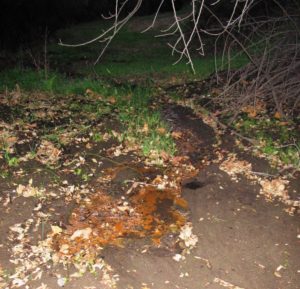
“Regarding the Campsite Area I drainage, please acknowledge the limitations of that work,” radiation physicist Joel I. Cehn says in the report, critiquing its inadequacies. Cehn has been Brandeis-Bardin’s an environmental contractor for decades. “There is a 1,200 ft. gap between the lowest soil sample at the top of the hill (BB-17) and the highest soil sample at the bottom (BB-20). This area was not explored. Thus, we cannot confirm that only one ravine is involved, nor how far down the hill the contamination extends. Recall that both tritium and Cesium-137 were detected at the bottom of BB-17. Samples further down the hill could not be collected due to steep terrain, resulting in this 1,200 ft. gap.”
The 1995 report showed that tests at BB-03 in 1994 found both Cs-137 and Sr-90 that would be substantially over background values derived by the EPA in 2011 and published in 2012. A Cs-137 sample radiated 65.9 percent over its background. The tests provided to EnviroReporter.com a decade later showed it was still there lending credence to the likelihood that Cs-137 and Sr-90 may still plague the Campsite Area I site.












Have there been any reports of children getting cancer who have attended the camp
OPEN LETTER – “Are Jews at Brandeis-Bardin immune to radiation and chemicals?”
[Published on EnviroReporter.com in comments for “Brandeis-Bardin’s Toxic Denial” 2017 exposé at https://www.enviroreporter.com/2017/04/brandeis-bardins-toxic-denial/all/1/]
To: Ms. Rachel Levin, contributor to the New York Times Travel section
via http://byrachellevin.com/
From: Michael Collins, EnviroReporter.com
Regarding: New York Times September 18, 2019 Travel section article “Jewish Summer Camp With Campfires, Crafts and No Lights Out” by Rachel Levin at https://www.nytimes.com/2019/09/18/travel/jewish-adult-summer-camp.html
Ms. Levin,
Your article on the Jewish camp at Brandeis-Bardin in Simi Valley, California, would have been better informed if you had noted that “fission products” and radionuclides “used in reactor control rods” have been found at Brandeis-Bardin according to U.S. Department of Energy (DOE) reports. DOE operated above and bordering the camp at the heavily polluted Santa Susana Field Laboratory (SSFL) which experienced three partial nuclear meltdowns.
Perhaps you should have told your readers that 600 acres of SSFL drain into Brandeis-Bardin where elevated levels of radionuclides have been found in the soil, surface water and subsurface water including Strontium-90, Plutonium-239/240, Uranium-238 and beta radiation.
Your piece might have been more informative, and accurate, if you let your readers know that SSFL owner Boeing paid off Brandeis-Bardin $3.2 million for polluting its land in the late 1990s and bought much of the contaminated border property from the camp to serve as a new “Northern Buffer Zone.”
Jews, and other New York Times readers, might have been better served being informed that SSFL was first started to test Nazi war criminal and SS officer Wernher von Braun’s V-2 war rockets, the production of which cost 20,000 Mittelbau-Dora concentration camp inmates their lives with 9,000 dying from exhaustion alone. About 350 of these Nazi slaves were hanged, including 200 for sabotage, with the remainder shot or dying from disease and starvation.
Our online news organization’s website EnviroReporter.com, KNBC‘s I-Team and Jewish Journal have covered the contamination problems at the camp yet you and the New York Times fail to even allude to them.
A correction at the end of the piece confirms that Brandeis-Bardin’s name was misspelled in the original copy. That suggests that not a lot of fact-checking was done for this feel good travel piece that unfortunately forgot the meltdowns, Nazi rockets and contamination emanating from high above, and bordering the Jewish camp.
Michael Collins
EnviroReporter.com
Interesting new 2018 data in the Northern Buffer Zone that drains into the American Jewish University’s Brandeis-Bardin Campus.
https://www.dtsc-ssfl.com/files/lib_rcra_groundwater/quarterly_an_gw_repo/quarterly/68374_2018_Q3_Groundwater_Level_Monitoring_Report.pdf
Wells RD 33 A and C were found “Tampered With” yet in the polluters technical memorandum they are marked as non-detect.
https://www.dtsc-ssfl.com/files/lib_rcra_groundwater/interimmeasures/correspondence/68375_DOE_GWIM_Status_Tech_Memo_11-10-18.pdf
I guess that’s one way to cancel out “True Findings” or the other way is blatantly saying in the report that they are “False Positives” or “Anomalies” when Radioactivity (Strontium 90) was found in well RD-59 A and C
https://www.dtsc-ssfl.com/files/lib_rcra_groundwater/quarterly_an_gw_repo/quarterly/68374_2018_Q3_Groundwater_Level_Monitoring_Report.pdf
We NEED Independent Testing.
We NEED offsite Testing.
To ensure the safety of the surrounding communities.
Former Los Angeles Times environmental journalist Deborah Schoch has a comprehensive piece on Brandeis-Bardin’s contamination woes in a new NBC4 I-Team exclusive entitled Popular Kids’ Camp: Scientists Raise New Safety Concerns – Top scientists raise questions about a nearby former nuclear testing site and whether it poses risks to campers
Schoch’s exposé is a real eye-opener and seeks the opinions of expert scientists about whether the Jewish camp is safe for the thousands of children, and adults, who attend it each year to be part of Camp Alonim. The scientists are concerned about kids eating food grown in Brandeis-Bardin’s considerable vegetable gardens and orchard trees, especially since the officials of American Jewish University, which owns the camp, have consistently denied any such consumption:
“Most definitely there were gardens, and the kids would pick the produce, and it was cooked for dinner,” said Rabbi Laurie Hahn Tapper, who directed the Brandeis Camp Institute summer program from 2005 to 2007.
There are also concerns about missing data in environmental tests of the land as well as finding that:
Test results cited by the camp and state regulators are either too old or too inconclusive to definitely say whether children are safe from contamination from the Field Lab, several scientists said.
A 2016 study paid for by the camp’s owner, to investigate concerns about contamination, is flawed, according to UC Irvine public health professor Oladele Ogunseitan.
Schoch’s tenacity is why we are even able to read this fine reportage. Jewish Journal‘s new editor told her he would not be publishing the work. That didn’t stop Schoch. Now Jewish Journal‘s loss is NBC4‘s gain for which we owe a debt of gratitude. Work well done!
NBC4‘s I-Team has just come out with a blistering report with Scientists Question State Report on Camp Safety.
Seems some of the DTSC and AJU players in our piece could be in “collusion” says one of the I-Team’s whistleblowers. Here’s a snippet of the transcript of the dynamite video segment:
In the email to DTSC Project Team Manager Mark Malinowski, Rabbi Jay Strear of the American Jewish University writes “the KNBC report creates an urgent matter for us. I need to speak with you asap and am willing to come to Sacramento to meet with you {sic} any other needed DTSC officials.”
Strear goes on to attack the facts of the NBC4 reports, saying “we are in a highly compromised position and believe the only repair is through a definitive statement by DTSC substantiating your stated position that our property is safe.” He ends the email by saying, “Timing is most critical. We must produce something in the next 24 hours or we risk significant damage.”
The I-Team has done a superb and fearless job taking these people to task. EnviroReporter.com will be following up Brandeis-Bardin’s Toxic Denial in the near future and the I-Team’s piece will be part of the puzzle we’ve put together over the 13 years of our Brandeis-Bardin’s Toxic Denial INVESTIGATION.
As long as there is radioactive stuff on those 2 properties there is a possibility that there is a “continuing tort” against unsuspecting people who are “invited” to go on AJU’s property. Right now, BBI is actively seeking people to come to summer camp 2017.
I personally think Boeing and AJU are completely nuts to not remediate and protect BBI and the people continually being invited to go to BBI because of the risk of tort litigation by “the innocents”. This is even if the rest of the people living around SSFL have lost their right to sue Boeing because the statue of limitations has run out which is what several trial court judges said about 15 years ago.
A judge cannot impute knowledge about the “danger of exposure” to adult visitors or parents of child visitors to BBI, or new employees working at BBI, who live in Orange County, Bay Area or out of state.
Ignoring this information and not acting upon it will not only suggest the responsible parties’ culpability in the matter to most people, it will allow this scandal to continue and more people being exposed. That may cost AJU more than the millions it makes hosting these “innocents” in a place I wouldn’t walk my dog at.
Thank you commenters for your kind words and the detailed legal analysis.
Some related news: DTSC sent EnviroReporter.com its DTSC Comments on DOE’s DEIS two days ago and it is surprising in its insistence that DOE abide by its AOC. This strong stance has been greeted with optimism by people in the pro-cleanup community. DTSC’s objections, summarized in its own words, follow:
DTSC’s Key Concerns with DOE’s DEIS
1. The DEIS fails to only include alternatives that describe how DOE will comply with the 2010 Administrative Order on Consent (AOC). This is inconsistent with DOE’s earlier statement describing the cleanup’s purpose and need. Given this, we must reiterate that DTSC will hold DOE accountable for complying with the AOC.
2. The DEIS fails to provide sufficient information or analysis for DTSC to determine if any of the DEIS’ alternatives would comply with the AOC.
3. The DEIS describes at length a number of challenges to implementing of the AOC, however, it fails to take a hard look at how to overcome those challenges, including:
a. Inadequate survey, analysis, and use of agreed upon processes to identify potential options for acquiring clean backfill soil. DOE will use this soil to achieve
cleanup standards and restore the land’s natural contours following the removal of contaminated soil.
b. Conclusory statements about DOE’s inability to achieve the AOC’s preliminary cleanup standards, which are contained in the project’s “Look-Up Table” (LUT), without a thorough examination of available options for overcoming those challenges.
4. The DEIS assumes habitat for protected plants and animals is exempted from cleanup, but fails to explain how DOE proposes to utilize the AOC’s process of conferring with state and federal agencies on site-specific decisions to protect habitat.
5. The DEIS proposes to rely on the natural process of degradation (monitored natural attenuation) to reduce levels of certain contaminants to achieve cleanup standards, which may take decades and therefore violate the AOC’s prohibition on leaving contamination where it is found. Moreover, the DEIS fails to examine ways to accelerate the natural degradation process.
6. The DEIS assumes trucks will use 2019 air pollution control technology over the estimated 15-year timeline for the cleanup. This fails to account for the use of improved air pollution control technologies over time, which in turn undercuts the analysis needed of the project’s potential air pollution impacts.
Thank you for this amazing work that even I get. That’s great journalism. Thank you. The people are getting conned out of millions and getting no cleanup. It is an outrage.
If you hadn’t backed up this information I might not have believed it. Wow. Not good. One week since this came out and nothing from American Jewish University, Jewish Journal or Department of Energy? Their silence speaks volumes.
Putting the best possible spin on it, perhaps the good folks at Brandeis-Bardin Institute were simply unaware of the extent to which the toxic SSFL run-off could pollute their land. But now, Collins has documented it. BBI cannot blow this off, the health of way too many people is at stake.
A very complete and worrying description of contamination problems associated with SSFL and nearby lands. I would be concerned about residents and visitors who unknowingly come into contact with the airborne and waterborne effluent leaching from the hills and watersheds surrounding SSFL. Although the story mentions some warning signs on the Brandeis-Bardin property, I wonder if publicly accessible hiking trails in the area are similarly marked. And, of course, one wonders just how far the contaminates could migrate from the SSFL property. The very long half-life radionuclides could seep into groundwater supplies if given enough time. I lived within earshot of the SSFL Saturn IVB engine tests of the 1960s. But at the time, I had no idea of the trouble that would develop years later due to the research activities at SSFL. I hope that articles like this one will stir action within the community and from local governments to bring closure to the SSFL cleanup project. Thank you, Michael Collins, for writing this important investigative article.
To Michael Collins: I am beyond impressed with your very clear organization and explanation of many years of test results relating to the Brandeis-Bardin Institute’s property, and the implication that the parties involved don’t want to admit the degree of contamination that the tests show.
To the community of “Rocketdyne clean up activists” and visitor/camper/employees at Brandeis-Bardin Institute who may react to this Enviroreporter report with a question or a plea to the current decision makers for Brandeis-Bardin Institute “Why don’t you do something to make the clean-up of toxic and radioactive contamination happen” I hope to provide an answer as to why they most likely won’t.
The reason “they won’t do something” is in large part because the Board of Directors of American Jewish University, as the parent non-profit company to the non-profit owner of the Brandeis-Bardin property, are bound to a 1997 “Settlement and Release Agreement” between Boeing North America and Brandeis-Bardin Institute.
In essence, back in 1997 Brandeis-Bardin Institute’s decision makers decided release all of their past and future claims against Rocketdyne/Boeing and to put their faith in Federal, California and regional toxics regulatory agencies to “do the right thing” and decide upon the details of further clean-up of hazardous substances and radioactive substances on, under and near the Brandeis-Bardin Institute’s property.
Assuming that back in 1997 the Brandeis-Bardin Institute’s decision makers expectation was that the government agencies WOULD require additional soil and ground water clean-up by Boeing on and around Brandeis-Bardin Institute’s land, the sad fact is that 20 years later little has been done in terms of remediation improving the conditions of the Brandeis-Bardin Institute’s land or the Boeing land directly upstream from it or adjacent to it.
Assuming that back in 1997 the Brandeis-Bardin Institute’s decision makers expectation was that the government agencies WOULD require additional soil and ground water clean-up, the Settlement and Release Agreement they entered into with Boeing prevents Brandeis-Bardin Institute or its successor land owner from prosecuting any lawsuits NOW to try to force any such remediation.
One might say that given the wording of the Settlement and Release Agreement entered into by Brandeis-Bardin Institute in 1997, they shot themselves in the foot.
Back in 2015, when NBC Los Angeles was running its investigative news stories about Rocketdyne related contamination of Brandeis-Bardin Institute, NBC LA posted documents on its website which it believed supported its investigative news stories. The posted documents directly relate to the anguish exhibited today by “clean up Rocketdyne” activists and former Brandeis-Bardin Institute campers from around the state who are dismayed by the California Department of Toxic Substances Control and multiple Federal agencies desires to not order much if any remediation of radioactive and toxic substances on, under and near the Santa Susana Field Lab or Brandeis-Bardin Institute.
Among those documents posted online by NBC LA in 2015 was a letter dated October 23, 1997 from the late Judge Joseph A. Wapner to Brandeis-Bardin Institute’s lawyer Barry I. Goldman, enclosing the Settlement and Release Agreement with Boeing North America signed by Judge Wapner in his capacity as President of the Brandeis-Bardin Institute (“BBI”). In the letter Judge Wapner wrote to Mr. Goldman “Enclosed please find the original Settlement and Release Agreement signed by me as President of the Brandeis-Bardin Institute. I certainly hope this matter will be concluded soon. I know that you are doing everything in your power toward that end for which I sincerely thank you.”
The copy of that letter obtained by NBC LA showed a “cc” to Dr. Alvin Mars, the then Executive Vice President of Brandeis-Bardin Institute. In the style of secretaries in the 1990’s the “cc” to Dr. Alvin Mars had a little check mark next to it on the letter posted online by NBC LA, showing that the particular copy of the letter was the copy physically sent to Dr. Mars by Judge Wapner’s secretary. As a result one can conclude the copy of the letter and its attachment obtained by NBC LA has an appearance of authenticity because it likely came from (1) Dr. Mar’s file on the Rocketdyne/Boeing litigation, (2) a file maintained at the offices of Brandeis-Bardin Institute or (3) a file maintained by a person or entity who was authorized to receive a copy under that Settlement and Release Agreement’s terms.
To my knowledge, no copy of the “counterpart” of that Settlement and Release Agreement signed by Boeing North America (“BNA”) as corporate successor-by-merger to Rocketdyne, Inc. has been published by any media source.
From the text of that Settlement and Release Agreement attached to the letter described above it is fairly clear that neither Brandeis-Bardin Institute nor Boeing North America intended the text of that Settlement and Release Agreement be made public. All that Brandeis-Bardin Institute and Boeing North America intended the public see would be a one page “Dismissal With Prejudice” of the U.S. District Court case captioned The Brandeis-Bardin Institute v. Rocketdyne, Inc. et al. Case No. CV-95-8316 ABC (RMCx) signed by Brandeis-Bardin Institute’s lawyer. That practice of filing a one page dismissal of a lawsuit with the U.S. District Court without court-filing of the parties’ actual Settlement and Release Agreement is and has been very common for decades.
However, given the veneer of authentication of the version of the 1997 Settlement and Release Agreement signed by Brandeis-Bardin Institute in the late Judge Wapner’s letter described above, it is worth looking at the text of that Settlement and Release Agreement to understand the rights (or lack thereof) of Brandeis-Bardin Institute and the American Jewish University subsidiary which owns the Brandeis-Bardin Institute land today.
As a result readers should direct their attention to the that 1997 Settlement and Release Agreement, quoted below, and showing that Brandeis-Bardin Institute gave Boeing North America the customary ironclad release of known and unknown claims arising out of known and unknown facts related to the general subject of the lawsuit. In that Settlement and Release Agreement text “BBI” means Brandeis-Bardin Institute and its subsidiaries, and its successor entities and their subsidiaries and “BNA” means Boeing North America and its predecessor owners of the Santa Susana Field Lab, as well as their subsidiaries and successors in ownership or operation of the Field Lab.
The only comfort the release paragraphs in that Settlement and Release Agreement provide is that Brandeis-Bardin Institute did not purport to release claims held by “other people” who attended events at the property or who camped or ate food grown at the property.
That Settlement and Release Agreement does not describe, in any detail, the hazardous or radioactive substances found or alleged to be found, or not found, on any part of Brandeis-Bardin Institute’s property, including the part deeded over to a Boeing North America subsidiary in early 1998 as part of the implementation of the settlement.
Settlement and Release Agreement Section III Paragraph 1 provides: “General Release. BBI hereby releases and forever discharges BNA of and from any and all claims of any kind or nature, under any theory, whether legal, equitable or other, under the law, either common, constitutional, statutory, regulatory or other, of any jurisdiction, foreign or domestic, whether such claims are known or unknown, suspected or unsuspected [sic], including claims that BBI has brought or could have brought, which now exist or in the future may exist, arising out of or in any way related to events or matters referred to or which could have been referred to directly or indirectly in the Action [the Federal court case], including but not limited to, claims relating to hazardous substances at or emanating from the BBI site and the Field Lab.”
Settlement and Release Agreement Section III Paragraph 2 provides: “Waiver Under California Civil Code 1542. It is understood that 1542 of the Civil Code of California provides as follows: “A GENERAL RELEASE DOES NOT EXTEND TO CLAIMS THE CREDITOR DOES NOT KNOW OR SUSPECT TO EXIST IN HIS FAVOR AT THE TIME OF EXECUTING THE RELEASE, WHICH IF KNOWN BY HIM MUST HAVE MATERIALLY AFFECTED HIS SETTLEMENT WITH THE DEBTOR.” BBI expressly waives and releases any right or benefit which it has or may have under 1542 of the Civil Code of the State of California, to the extent it may waive all such rights and benefits pertaining to the matters released herein. In connection with such waiver and relinquishment, BBI acknowledges that it is aware that it may hereafter discover claims presently unknown or unsuspected, or facts in addition to or different from those which it now has or believes to be true, with respect to matters released herein. Nevertheless it is the intention of BBI, through this Agreement, and with the advice of counsel, fully, finally and forever to settle and release all such matters, and all claims relevant thereto, which do now exist, may exist or heretofore have existed between BBI and BNA. In furtherance of such intention, the release herein given shall be and remain in effect as a full and complete release of such matters notwithstanding the discovery or existence of any such additional different claims or facts relative thereto.”
The 1997 Release and Settlement Agreement DOE contain “custom drafted promises” between Brandeis-Bardin Institute and Boeing North America concerning remediation and non-remediation of hazardous substances found on the Brandeis-Bardin Institute property after the settlement went into effect. Those custom drafted provisions are found at Article III, Section 7 (page 8) of that Settlement and Release Agreement. Those paragraphs generally leave decision making about remediation to “regulatory agencies”, cutting Brandeis-Bardin Institute out of the decision-making process:
Settlement and Release Agreement Section III Paragraph 7a: “Remediation of Hazardous Substances a. BNA shall continue to investigate and remediate under the direction of regulatory agencies the hazardous substances emanating from the Field Lab. BBI shall fully cooperate with BNA, giving BNA access to the BBI Site, in connection with BNA’s investigation and remediation under the direction of the regulatory agencies of hazardous substances on the BBI Site emanating from the Field Lab. The scope of BNA’s investigation and remediation of hazardous substances shall be determined by the regulatory agencies, and not by BBI. BNA shall be responsible for remediation of the Parcels required by the regulatory agencies…”
To the public that Section III, Paragraph 7a is the most important provision in the Settlement and Release Agreement. In layman’s language, Brandeis-Bardin Institute promised not to demand any clean-up of hazardous substances (by definition in the Agreement including radioactive substances) on the Field Lab or on Brandeis-Bardin Institute’s remaining property other than clean-up required by “regulatory agencies” which by definition in Article I, Section 3 did NOT include Ventura County or any city.
As a result of that Settlement Agreement’s text at Section III Paragraph 7a, if the regulatory agencies do not require remediation to background level, Brandeis-Bardin Institute is stuck with that decision as to its own property and as to the Field Lab property adjoining it. If the regulatory agencies only require 39% of the hazardous or radioactive substances, Brandies Bardin Institute is stuck with that decision. The only power Brandeis-Bardin Institute still has, under that Settlement Agreement, is to do its own elective remediation of its own property after the regulatory agencies have relieved Boeing North America and its affiliates from any further remediation obligation.
Settlement and Release Agreement Section III Paragraph 7b provides: “b. Before selling, leasing, or otherwise conveying an interest in the BBI Site or any part thereof, BBI (i)shall provide a copy of this Agreement and make full disclosure of BBI’s obligation to cooperate fully with BNA, including giving BNA access to the BBI Site, in connection with BNA’s investigation and remediation under the direction of the regulatory agencies of hazardous substances on the BBI Site emanating from the Field Lab, (ii) shall obtain the written covenant from all persons acquiring an interest in the BBI Site or any part thereof in the form attached hereto as Exhibit C, and (iii) shall forward such covenant to BNA within five (5) days.”
In effect, Exhibit C was to be a binding admission by Brandeis-Bardin Institute as to the implied risks presented by its real estate being located adjacent to the Santa Susana Field Lab.
Unfortunately, the version of the Release and Settlement Agreement which Judge Wapner signed as President of Brandeis-Bardin Institute, and which NBC LA posted online, did not have Exhibit “C” attached. That is not unusual. Officers of corporations typically leave it to their company’s lawyers to approve the wording of exhibits and attach them to the “official” copies of settlement agreements. No other copies of the final version of Exhibit “C”, approved by the lawyers for Brandeis-Bardin Institute and Boeing North America, has surfaced in the press.
If Brandeis-Bardin Institute actually fulfilled its contractual promise to Boeing North America in that Settlement and Release Agreement’s Section III, Paragraph 7b quoted above, language mirroring the missing Exhibit “C” should have been signed by the lender under any deeds of trust recorded with the approval of Brandeis-Bardin Institute in connection with its borrowing against the BBI Site prior to or after American Jewish University’s acquisition of control of BBI. A document mirroring the text of Exhibit “C” should have been signed by any recipient/grantee of easements over the BBI Site, such as those which the BBI Site property owner granted to neighboring residential real estate developers, utility companies or the City of Simi Valley. The text of Exhibit “C” should have been included in one of the documents under which the BBI Site was deeded to a subsidiary of American Jewish University.
Brandeis-Bardin Institute’s “admission” in Exhibit “C”, or in documents quoting Exhibit “C” would be of great interest to any individual claiming that they or American Jewish University had a moral, ethical or legal obligation to disclose hazardous substances health risks associated with humans physically being on the BBI Site for any extended period of time. Documents with the Exhibit “C” wording may or may not have been filed with the Ventura County Recorder, because that Settlement and Release Agreement does not require that such a recording be made. As far as I know, no member of the press has publicized Exhibit “C” or a similar document pertaining to the parts of the BBI Site which Brandeis-Bardin Institute, American Jewish University, or their land-owning subsidiary which was recorded in those Ventura County Official Records in 1998 or later.
Other the requirement that Brandeis-Bardin Institute make an Exhibit “C” written disclosure to any legal person obtaining an interest in the BBI Site, the Release and Settlement Agreement between Brandeis-Bardin Institute and Boeing North America contains a broad non-disclosure agreement about that Settlement Agreement binding on Brandeis-Bardin Institute and, through a provision not quoted below, its subsidiaries, affiliates and successors:
Settlement and Release Agreement page 13, Article III, Section 18: “Non-Disclosure. The parties agree not to disclose in any way the terms or conditions of this Agreement to any person other than their counsel, auditors, insurance carriers, lenders, officers and directors, each of whom shall be informed of, and bound by, the confidentiality terms of this Agreement, except in response to a lawful subpoena or other lawful process or as may be required by an independent auditor, or as part of an effort to enforce the terms of this Agreement. In the event that a party believes that disclosure is otherwise required by law or is necessary to enforce this Agreement, it shall give prompt written notice via overnight delivery to the other parties to this Agreement prior to disclosing such information….Said notice shall set forth all of the information which the party to this Agreement proposes to disclose, the statute or other legal authority purportedly requiring disclosure, and the circumstances pursuant to which disclosure is to be made. If the party providing notice to the other party receives no notice within ten (10) days that the other party intends to seek to prevent disclosure, it may produce this Agreement…:
Since the counterpart of that Settlement and Release Agreement signed by Boeing North America has not publicly surfaced, and since the content of Exhibit “C” has not become public, one cannot say with 100% certainty that the Settlement and Release Agreement signed by the late Judge Wapner in October 1997 and posted online by NBC LA is the final version of the document. At the very least litigation and toxics lawyers would say that the document’s content looks like one which would have met with the approval of Boeing’s lawyers in 1997 as being a “customary” form of settlement agreement relating to hazardous materials contaminated properties in California.
The text of that Settlement and Release Agreement does NOT bluntly require that Brandeis-Bardin Institute (or its successor land owners) not make public comment about hazardous substances or radioactive substances found on, under or near the Brandeis-Bardin Institute at any point in time before or after the settlement. The text of that Settlement and Release Agreement does NOT bluntly forbid Brandeis-Bardin Institute from “warning” people participating in activities on its property, camping or living there, about the past or current status of hazards on the Brandeis-Bardin Institute property (the “BBI Site” referred to in the Settlement Agreement) or the Santa Susana Field Lab/Rocketdyne property.
However, on a purely investment-minded level there was and still is little benefit to the owners of the Brandeis-Bardin Institute land in Simi Valley to besmirch the physical condition of their property or property owned by others next door, because Brandeis-Bardin Institute has a history of selling a part of its property for office/warehouse land development and it is conceivable that in the future the American Jewish University could decide to have its subsidiary which owns the Brandeis-Bardin Institute land sell parts of its remaining land for residential development. In that sense, it is in AJU’s economic interest that the Federal, California and regional agencies involved in investigating the history of Rocketdyne aka Santa Susana Field lab find that no further clean-up or protective land use regulations are required.